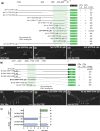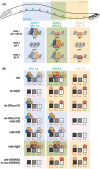Hox proteins interact to pattern neuronal subtypes in Caenorhabditis elegans males
- PMID: 35137058
- PMCID: PMC8982040
- DOI: 10.1093/genetics/iyac010
Hox proteins interact to pattern neuronal subtypes in Caenorhabditis elegans males
Abstract
Hox transcription factors are conserved regulators of neuronal subtype specification on the anteroposterior axis in animals, with disruption of Hox gene expression leading to homeotic transformations of neuronal identities. We have taken advantage of an unusual mutation in the Caenorhabditis elegans Hox gene lin-39, lin-39(ccc16), which transforms neuronal fates in the C. elegans male ventral nerve cord in a manner that depends on a second Hox gene, mab-5. We have performed a genetic analysis centered around this homeotic allele of lin-39 in conjunction with reporters for neuronal target genes and protein interaction assays to explore how LIN-39 and MAB-5 exert both flexibility and specificity in target regulation. We identify cis-regulatory modules in neuronal reporters that are both region-specific and Hox-responsive. Using these reporters of neuronal subtype, we also find that the lin-39(ccc16) mutation disrupts neuronal fates specifically in the region where lin-39 and mab-5 are coexpressed, and that the protein encoded by lin-39(ccc16) is active only in the absence of mab-5. Moreover, the fates of neurons typical to the region of lin-39-mab-5 coexpression depend on both Hox genes. Our genetic analysis, along with evidence from Bimolecular Fluorescence Complementation protein interaction assays, supports a model in which LIN-39 and MAB-5 act at an array of cis-regulatory modules to cooperatively activate and to individually activate or repress neuronal gene expression, resulting in regionally specific neuronal fates.
Keywords: Caenorhabditis elegans; BiFC; Hox genes; TALE homeodomain proteins; male-specific neurons; neurogenesis; ventral cord neurons.
© The Author(s) 2022. Published by Oxford University Press on behalf of Genetics Society of America. All rights reserved. For permissions, please email: journals.permissions@oup.com.
Figures







References
-
- Alper S, Kenyon C.. The zinc finger protein REF-2 functions with the Hox genes to inhibit cell fusion in the ventral epidermis of C. elegans. Development. 2002;129(14):3335–3348. - PubMed
Publication types
MeSH terms
Substances
Grants and funding
LinkOut - more resources
Full Text Sources
Research Materials

